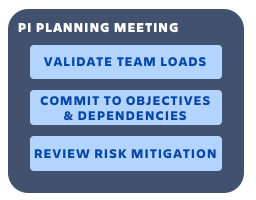Introduction

“Unless commitment is made, there are only promises and hopes; but no plans.” - Peter F. Drucker (Author)
Planning as a program on a regular cadence enables a program to align and synchronize with each other. This alignment enables teams to coordinate with each other, increases the likelihood of delivering on commitments, and ensures those commitments are still desired by stakeholders.
Decisions to make
- Create a transparent plan of how the teams are going to make a commitment to the prioritized list of features
- Confirm that the plan is aligned to business value through team and program-level objectives
- Capture all risks and dependencies that could impact our ability to meet our plan
Context
- Teams leverage cadence-based planning cycles to identify and commit to work together (vs. individually)
- Teams and the program have an understanding of how much work they can commit to for a planning period based on historical performance
- Risks to execution are tracked to improve the likelihood of meeting commitments made during planning
Why we care
- Building enterprise-scale systems requires strong coordination amongst many autonomous teams
- The planning event (e.g. PI planning) is the event that aligns all the teams on the program to a shared mission and vision
The Atlassian view
- The program board, program room, and roadmaps are key pages used for planning
- The program board displays the timing and status of objectives and dependencies defined for the planning period
- Dependency maps show various relationships of dependencies across the teams
- The risk ROAM report captures the risks and statuses
- Action items are captured from the planning event to be tracked during execution
Next step:
Jobs to be doneWas this content helpful?
Connect, share, or get additional help
Atlassian Community